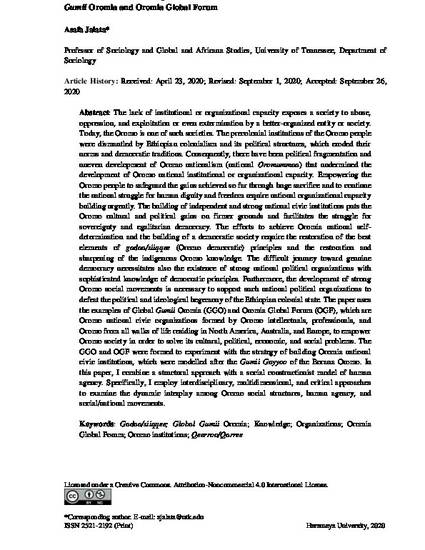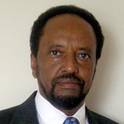
Article
Asafa-Manuscript no. 31-2020-published-pg.1-20.pdf
East African Journal of Social Sciences and Humanities (2020) Volume 5 (2) 1-20
(2020)
Abstract
The lack of institutional or organizational capacity exposes a society to abuse, oppression, and exploitation or even extermination by a better-organized entity or society. Today, the Oromo is one of such societies. The precolonial institutions of the Oromo people were dismantled by Ethiopian colonialism and its political structures, which eroded their norms and democratic traditions. Consequently, there have been political fragmentation and uneven development of Oromo nationalism (national Oromummaa) that undermined the development of Oromo national institutional or organizational capacity. Empowering the Oromo people to safeguard the gains achieved so far through huge sacrifice and to continue the national struggle for human dignity and freedom require national organizational capacity building urgently. The building of independent and strong national civic institutions puts the Oromo cultural and political gains on firmer grounds and facilitates the struggle for sovereignty and egalitarian democracy. The efforts to achieve Oromia national self-determination and the building of a democratic society require the restoration of the best elements of gadaa/siiqqee (Oromo democratic) principles and the restoration and sharpening of the indigenous Oromo knowledge. The difficult journey toward genuine democracy necessitates also the existence of strong national political organizations with sophisticated knowledge of democratic principles. Furthermore, the development of strong Oromo social movements is necessary to support such national political organizations to defeat the political and ideological hegemony of the Ethiopian colonial state. The paper uses the examples of Global Gumii Oromia (GGO) and Oromia Global Forum (OGF), which are Oromo national civic organizations formed by Oromo intellectuals, professionals, and Oromo from all walks of life residing in North America, Australia, and Europe, to empower Oromo society in order to solve its cultural, political, economic, and social problems. The GGO and OGF were formed to experiment with the strategy of building Oromia national civic institutions, which were modelled after the Gumii Gayyoo of the Borana Oromo. In this paper, I combine a structural approach with a social constructionist model of human agency. Specifically, I employ interdisciplinary, multidimensional, and critical approaches to examine the dynamic interplay among Oromo social structures, human agency, and social/national movements.
Keywords: Gadaa/siiqqee; Global Gumii O
Keywords
- Gadaa/siiqqee; Global Gumii Oromia; Knowledge; Organizations; Oromia Global Forum; Oromo institutions; Qeerroo/Qarree
Disciplines
Publication Date
Fall December, 2020
Citation Information
East African Journal of Social Sciences and Humanities (2020) Volume 5 (2) 1-20
Creative Commons license

This work is licensed under a Creative Commons CC_BY-NC International License.
